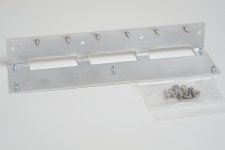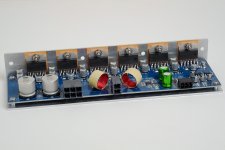First off, 11 A peak is not enough for a Modulus-686. The '686 can deliver 33 A (typical). With a 4 Ω resistive load, it'll deliver 15-16 A peak to the load near clipping. So forget the SMPS500, please.
Tom
From the Mean Well RPS-400-36 datasheet:
Current: with 25CFM fan cooling 11,2A without fan 7A
and consequently the Power: with fan 403W without 252W
Not so different ....
Said this I am orienting always more on a more traditional and convenient toroidal transformer + rectifier-capacitor
Except the Connex "spec" assumes a 10 dB crest factor, whereas Mean Well's spec is for continuous DC current. You're not comparing apples to apples here.
You are correct about the power. This is specified in the Mean Well data sheet. 250 W at convection cooling. 400 W with forced air (25 CFM). There's no specification of how much power the Connex SMPS800RE can handle without forced air cooling. Only that if the chassis is "too tight" you need to use fan cooling.
In my experience with the Mean Well units, I've found that they can deliver considerably higher current on the peaks than their specified DC current. I have several SMPSes that I've run at Ipeak = IDC_max*sqrt(2) and that has worked out just fine. It does help that in a Class AB amp, the supply delivers current in half-cycle pulses.
I do agree that finding an SMPS that's suitable for the Modulus-686 is a challenge. On the other hand, finding a suitable unregulated supply is easy. The regulated supply also has the advantage of a more graceful overload recovery than the hard power cycle offered by the switcher (or blown diode in case of the SMPS300RE).
Tom
You are correct about the power. This is specified in the Mean Well data sheet. 250 W at convection cooling. 400 W with forced air (25 CFM). There's no specification of how much power the Connex SMPS800RE can handle without forced air cooling. Only that if the chassis is "too tight" you need to use fan cooling.
In my experience with the Mean Well units, I've found that they can deliver considerably higher current on the peaks than their specified DC current. I have several SMPSes that I've run at Ipeak = IDC_max*sqrt(2) and that has worked out just fine. It does help that in a Class AB amp, the supply delivers current in half-cycle pulses.
I do agree that finding an SMPS that's suitable for the Modulus-686 is a challenge. On the other hand, finding a suitable unregulated supply is easy. The regulated supply also has the advantage of a more graceful overload recovery than the hard power cycle offered by the switcher (or blown diode in case of the SMPS300RE).
Tom
Last edited:
Except the Connex "spec" assumes a 10 dB crest factor, whereas Mean Well's spec is for continuous DC current. You're not comparing apples to apples here.
Tom
I have not found in Connex's doc what you have written: can you indicate me where?
And in your test I do see that you always used a Mean Well 600 series, for sure more powerful.
I linked to the SMPS800RE in Post #276 and to its data sheet in Post #280.
Yep. The SE-600-36 is more powerful. It's also forced air cooled with a rather loud fan, so not while it's great for lab testing it's not so useful for residential HiFi. I used the SE-600-36 to ensure that I didn't run out of current for the lab testing.
Tom
Yep. The SE-600-36 is more powerful. It's also forced air cooled with a rather loud fan, so not while it's great for lab testing it's not so useful for residential HiFi. I used the SE-600-36 to ensure that I didn't run out of current for the lab testing.
Tom
diyAudio member Cresnet has some SMPS that might be interesting for Mod-686 builders. Linking a post from the Vendor's Bazaar section - since discussion going on regarding SMPS options, trust this is ok?
Audio SMPS units for sale
There isn't a +/-36V model listed, but interested folks can ask the vendor.
Audio SMPS units for sale
There isn't a +/-36V model listed, but interested folks can ask the vendor.
Last edited:
Yeah. I chatted up that guy. He said he had a data sheet for his power supply but was unable to provide it in a format that I could read. He couldn't remember which voltages he had in stock. He was going to see if he had a ±36 V available and get back to me. That was three weeks ago. Must be a large warehouse... 
Tom
Tom
This power supply discussion makes me wonder...
Let's say you are using two SMPS one for positive and one for negative supply. Then there is an overload condition when f.ex. the output waveform is positive and so the positive supply shuts down, but the negative supply stays on. In that case, what happens at the speaker output?
Anybody tested this in practice? Any risk of damage to the amplifier or speaker?
Let's say you are using two SMPS one for positive and one for negative supply. Then there is an overload condition when f.ex. the output waveform is positive and so the positive supply shuts down, but the negative supply stays on. In that case, what happens at the speaker output?
Anybody tested this in practice? Any risk of damage to the amplifier or speaker?
Said this I am orienting always more on a more traditional and convenient toroidal transformer + rectifier-capacitor
Probably the safer bet at this moment.
Let's say you are using two SMPS one for positive and one for negative supply. Then there is an overload condition when f.ex. the output waveform is positive and so the positive supply shuts down, but the negative supply stays on. In that case, what happens at the speaker output?
Great question! During the prototyping stage, I did discover that the BPA architecture prefers a certain sequencing of the power supplies. Specifically, if the negative supply turns on before the positive, the LM3886es will draw a lot of current as the positive supply turns on. They will eventually recover, but it takes a few seconds. There were no ill effects to the amplifier or the speaker output, but I didn't like the "soft latch-up" condition, so I designed a little circuit to mute the LM3886es if one supply turns off.
So to answer your question: In case one supply shuts down (or turns on after the other), a circuit in the Modulus-686 will turn the LM3886es off.
Probably the safer bet at this moment.
I'll soon have a good solution for that.
Tom
Yep. That's the fully assembled and tested Modulus-686 option. The only thing not shown is the wiring harnesses and the input connector plug. They're included in the price of the fully assembled product.
For those who wish to build their own but still use the mounting bracket, I'll be selling the bracket as a product option. The bracket will come with the mounting hardware (screws, nuts, washers). You'll still need to provide the thermal pads, shoulder washers and additional components to go from the SMD pre-populated board option to the full build. Those bits add about $50.
Tom
For those who wish to build their own but still use the mounting bracket, I'll be selling the bracket as a product option. The bracket will come with the mounting hardware (screws, nuts, washers). You'll still need to provide the thermal pads, shoulder washers and additional components to go from the SMD pre-populated board option to the full build. Those bits add about $50.
Tom
Last edited:
I am wondering, perhaps hard anodizing on the heat sink would provide for sufficient insulation, but I guess I need to check what the thermal resistance of something like 35uM thickness would be. I remember in the past, when mica was used, we would rub the surface of the contact point to remove the anodized layer. So I am wondering what the options are to further lower thermal resistance .
Wonder if you came across the soft graphene pads by Panasonic? 28W/m-k in Z, 300-400 W/m-k in X-Y (although keeping in mind it does this at only 0.2 mm thickness).The Bergquist SilPad A2000 might edge out the other thermal pads. Now if I could only find a TO-264 size one on Mouser...
Tom
The small pads seem a bit expensive individually so I guess unless you're willing to stamp your own it's not going to be worthwhile. The big pads are only around 13c/sq.cm though.
... {snip} ...
No. I ran the amp at 130 W. The FTC requires that an amp can run at 1/3 its rated output power for an hour without overheating. 130 W is about 1/3 of the rated output power (a bit higher than 1/3 for the unregulated supply and a bit lower for the SMPS). I'm guessing the FTC used this operating point as it corresponds to a crest factor of 10 dB.
The worst case power dissipation is actually at half the rated output power.
Tom
The original FTC (1974) Rule required a pre-conditioning at one-third rated power into each rated impedance.
The current FTC rule has been modified (about 20 years ago, under pressure from audio manufacturers, in particular Home Theatre manufacturers) and now requires a pre-conditioning at one-eigth rated power into each impedance.
I avoid confusion by just referring to a one-third pre-conditioning as complying with the "FTC (1974) rule" so as not to confuse it with the currently enforced power rule, which I refer to as "FTC (2000) rule".
This distinction is helpful as both (and all subsequent versions) are technically called "FTC 16 CFR Part 432" and "Trade Regulation Rule Relating to Power Output Claims for Amplifiers Utilized in Home Entertainment Products."
Although not really related to your post, it is also worth remembering that the FTC 1974 rule also specified that the most prominently displayed advertised power output be rated into 8 ohms impedance only (even if the amplifier was designed primarily for output into other impedances). For other impedances, power claims had to be in smaller / less prominent text. The FTC (2000) rule also eliminated this impedance limitation, allowing ratings into other than 8 ohms to be the promeinent advertised rating. Similarly the requirement for power to be over a 20~20,000Hz power bandwidth was eliminated, and power could now be specified into 1KHz alone.
Finally the requirement that advertised power be at a specified THD distortion level was eliminated, although it was assumed this would only affect High End vacuum state amplifiers of greater than 1% THD where buyers were not as significantly concerned with very low distortion (and text specifically stating that was expressed in the rule change release), it was not anticipated it would lead to the (unspecified) 10% THD ratings we see now with many transistor designs, especially offshore eBay boards.
In all cases an amplifier had to survive the pre-conditioning and then meet the rated power output without issue; if there was any interruption of service over that time period, no power claim into the impedance under test could be made at any place in advertising or in a specification sheet.
Last edited:
- Home
- Vendor's Bazaar
- Modulus-686: 380W (4Ω); 220W (8Ω) Balanced Composite Power Amp with extremely low THD

